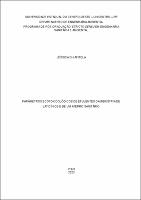| Compartilhamento |


|
Use este identificador para citar ou linkar para este item:
http://tede.unicentro.br:8080/jspui/handle/jspui/2149| Tipo do documento: | Dissertação |
| Título: | PARÂMETROS ECOTOXICOLÓGICOS DE EFLUENTES DA INDÚSTRIA DE LATICÍNIOS E DE UM ATERRO SANITÁRIO |
| Autor: | CHIAFITELA , JÉSSICA  |
| Primeiro orientador: | Martins, Kelly Geronazzo |
| Resumo: | O presente estudo teve como objetivo avaliar os parâmetros toxicológicos de dois efluentes distintos, utilizando bioindicadores, com foco na qualidade do ambiente aquático e em efluentes tratados. O primeiro efluente analisado foi proveniente da indústria de laticínios, antes de qualquer tratamento, e foi submetido ao bioensaio utilizando sementes de Lactuca sativa (alface). O teste fitotóxico com as sementes revelou que a concentração efetiva (CE50) para este efluente foi estimada em 48%, indicando uma toxicidade presente, porém não significativamente elevada. Nas diluições de 0,25% e 0,5%, o efluente apresentou efeitos estimulantes no alongamento da raiz. No entanto, nas diluições acima de 10%, foram observados efeitos fitotóxicos decorrentes da presença de cloreto. O segundo avaliou a eficiência do tratamento terciário do lixiviado de aterro utilizando lagoas Wetland por meio da análise de bioindicadores em dois níveis tróficos diferentes: hortaliças (Lactuca sativa e Allium cepa) e microcrustáceo (Daphnia magna). Foram coletadas amostras do efluente em dois pontos: antes do tratamento por Wetland (AW) e após tratamento por Wetland (PW) antes de ser descarregado no corpo receptor. O bioensaio com Lactuca sativa revelou que o efluente coletado AW apresentou fitotoxicidade, com inibição da germinação das sementes em uma diluição maior que 10%. Já o efluente coletado PW mostrou germinação em 100% das sementes, porém ocorreu com inibição na diluição acima de 30%. Para avaliar os efeitos do lixiviado na divisão mitótica, utilizou-se o efluente bruto sem diluição em Allium cepa, sendo observada degeneração celular no efluente AW e estímulo na divisão mitótica no efluente PW. O teste com Daphnia magna revelou que a concentração efetiva que resulta em 50% de mortalidade (CE50) para o efluente AW é obtida em uma diluição entre 1% e 2%, enquanto que para o efluente PW, a CE50 está próxima a 100%. Esses resultados indicam que o sistema Wetland é eficaz na redução da toxicidade do efluente, uma vez que, ao ser lançado no corpo receptor, dilui-se na zona de mistura. |
| Abstract: | The present study aimed to evaluate the toxicological parameters of two different effluents, using bioindicators, focusing on the quality of the aquatic environment and treated effluents. The first effluent analyzed came from the dairy industry, before any treatment, and was subjected to bioassay using Lactuca sativa (lettuce) seeds. The phytotoxic test with the seeds revealed that the effective concentration (EC50) for this effluent was estimated at 48%, indicating a present toxicity, but not significantly high. At dilutions of 0.25% and 0.5%, the effluent showed stimulating effects on root elongation. However, at dilutions above 10%, phytotoxic effects were observed due to the presence of chloride. The second evaluated the efficiency of tertiary treatment of landfill leachate using Wetland lagoons through the analysis of bioindicators at two different trophic levels: vegetables (Lactuca sativa and Allium cepa) and microcrustaceans (Daphnia magna). Effluent samples were collected at two points: before Wetland treatment (AW) and after Wetland treatment (PW) before being discharged into the receiving body. The bioassay with Lactuca sativa revealed that the effluent collected from AW showed phytotoxicity, with inhibition of seed germination at a dilution greater than 10%. The effluent collected PW showed germination in 100% of the seeds, but inhibition occurred at dilutions above 30%. To evaluate the effects of leachate on mitotic division, raw effluent without dilution in Allium cepa was used, with cellular degeneration being observed in the AW effluent and stimulation of mitotic division in the PW effluent. The test with Daphnia magna revealed that the effective concentration that results in 50% mortality (EC50) for the AW effluent is obtained at a dilution between 1% and 2%, while for the PW effluent, the EC50 is close to 100%. These results indicate that the Wetland system is effective in reducing the toxicity of the effluent, since, when released into the receiving body, it is diluted in the mixing zone. |
| Palavras-chave: | Daphnia magna Fitotoxicidade Sistema de raízes Ecotoxicologia Daphnia magna Phytotoxicity Root system Ecotoxicology |
| Área(s) do CNPq: | ENGENHARIAS ENGENHARIAS::ENGENHARIA SANITARIA |
| Idioma: | por |
| País: | Brasil |
| Instituição: | Universidade Estadual do Centro-Oeste |
| Sigla da instituição: | UNICENTRO |
| Departamento: | Unicentro::Departamento de Ciências Agrárias e Ambientais |
| Programa: | Programa de Pós-Graduação em Engenharia Sanitária e Ambiental (Mestrado / Associação Ampla com UEPG) |
| Citação: | CHIAFITELA , JÉSSICA. PARÂMETROS ECOTOXICOLÓGICOS DE EFLUENTES DA INDÚSTRIA DE LATICÍNIOS E DE UM ATERRO SANITÁRIO. 2023. 85 f. Dissertação (Programa de Pós-Graduação em Engenharia Sanitária e Ambiental - Mestrado / Associação Ampla com UEPG) - Universidade Estadual do Centro-Oeste, Irati-Pr. |
| Tipo de acesso: | Acesso Aberto |
| URI: | http://tede.unicentro.br:8080/jspui/handle/jspui/2149 |
| Data de defesa: | 1-Ago-2023 |
| Aparece nas coleções: | Programa de Pós-Graduação em Engenharia Sanitária e Ambiental (Associação com Universidade Estadual de Ponta Grossa) |
Arquivos associados a este item:
| Arquivo | Descrição | Tamanho | Formato | |
|---|---|---|---|---|
| Dissertação - Jéssica Chiafitela.pdf | Dissertação - Jéssica Chiafitela | 2,51 MB | Adobe PDF |  Baixar/Abrir Pré-Visualizar |
Os itens no repositório estão protegidos por copyright, com todos os direitos reservados, salvo quando é indicado o contrário.




